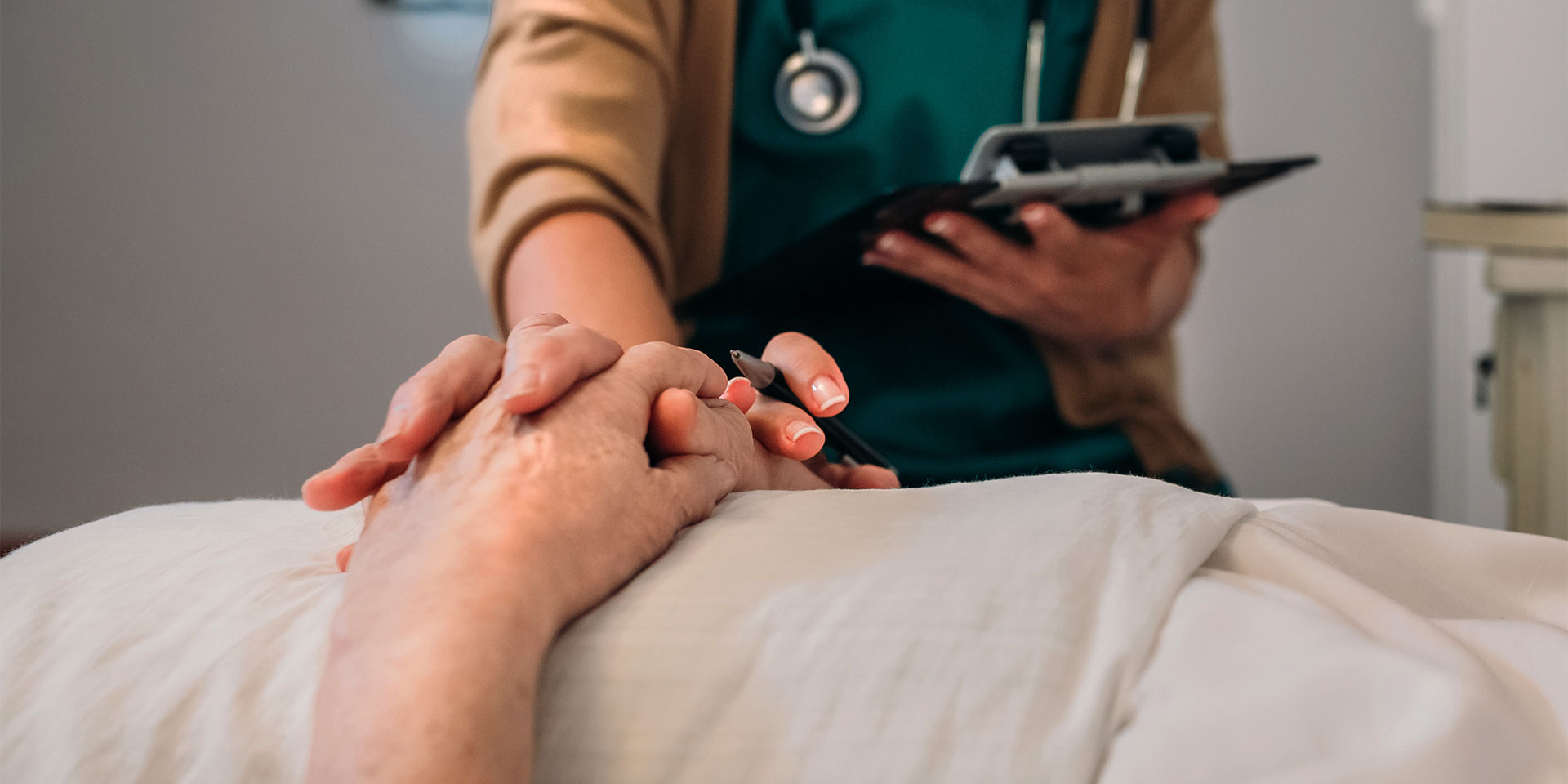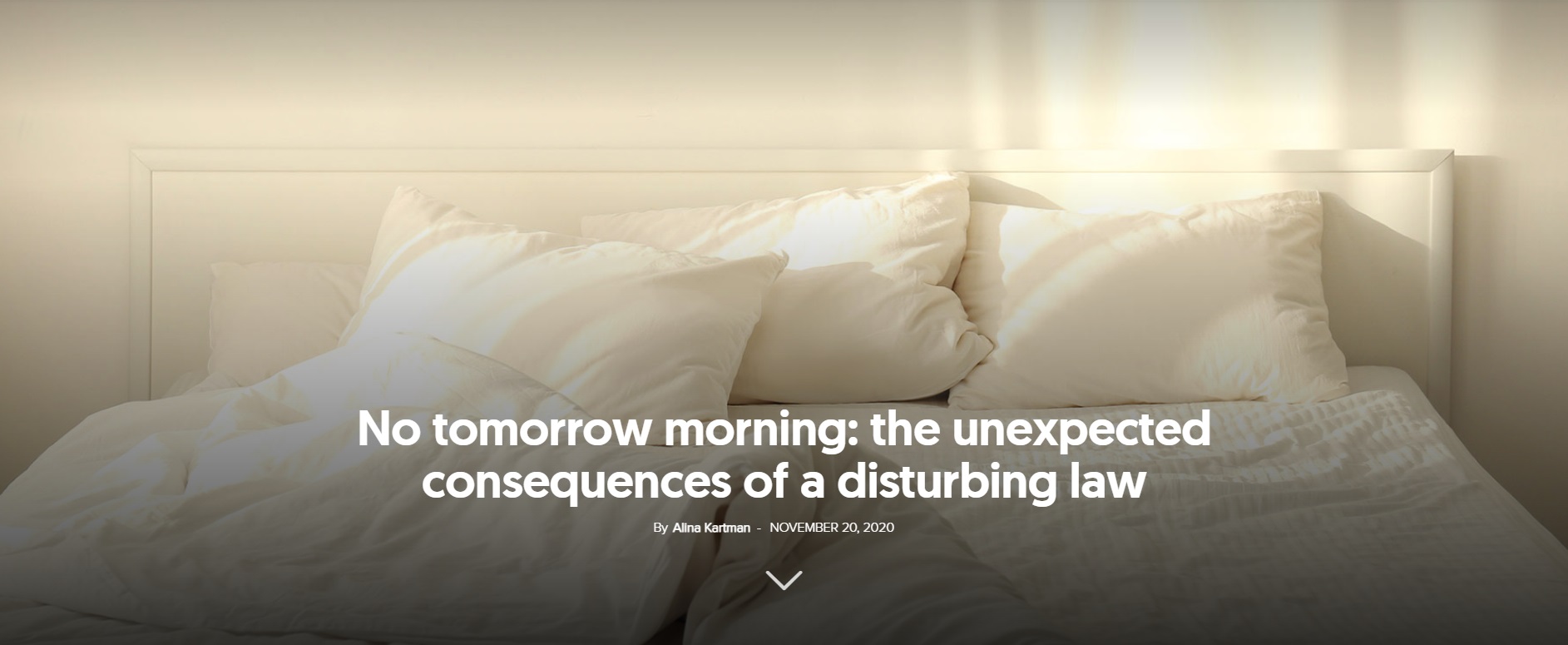When we want to position ourselves for or against voluntary euthanasia, we must first be aware that, in addition to the subjective dimension of the issue, there are also important objective aspects to consider.
When Christians oppose voluntary euthanasia, they are quickly labelled as misinformed or cruel. What else could justify their position in the face of a person who, tortured by pain or the prospect of its inevitability, only asks to be allowed to end their suffering with dignity?
In October, when Nathan Verhelst died, the tragedy was twofold. The 44-year-old Belgian had undergone three failed sex change operations. Feeling unable to resist the mental suffering caused by his new body, Nathan asked to be euthanized. Because Belgian law allows assisted suicide not only in conditions of unbearable physical suffering, but also in the case of overwhelming mental pain, doctors gave him what he wanted. “He died peacefully,” said one of the doctors who treated him. But who can say for sure?
Those who were by Nathan’s side in his last moments told Belgian reporters how, even a few hours before he died, he spoke of the fact that, since he was born, he had been “the girl no one wanted,” and his mother would complain that she did not have a boy. Nathan was actually born Nancy, the only girl in a family of three boys. His parents were waiting for the fourth, and apparently Nancy’s mother never accepted the idea that her expectations had been dashed, so she rejected the little girl. The girl grew up dreaming of becoming a boy.
He had prepared sweets to celebrate his “new birth,” but when he saw himself in the mirror, he was repulsed: “I was disgusted with myself,” he said.
In 2009, Nathan began taking steps to fulfill his dream. He first underwent male hormone therapy. Then he underwent breast tissue removal surgery. After this first measure he had a shock. He had prepared sweets to celebrate his “new birth,” but when he saw himself in the mirror, he was repulsed: “I was disgusted with myself,” he said. After the third operation, he told his relatives that he “doesn’t want to be a monster.” The body rejected the transplant that was supposed to turn Nancy into Nathan, and the mental pressure had become a suffocating mixture of regret and despair, which he no longer had the strength to fight.
Upon hearing the news of Nathan’s death, the woman who gave birth to him said dryly: “When I first saw ‘Nancy’, my dream was shattered. She was so ugly… I had a ghost birth. Her death does not bother me. For me, this chapter closed. Her death does not bother me. I feel no sorrow, no doubt or remorse. We never had a bond which could therefore not be broken.”
This story is disturbing in many ways. Probably, our first thoughts are that the suffering and the tragic end could have been avoided. If her parents hadn’t reacted so ridiculously to Nancy’s birth, if they hadn’t thrown her identity into confusion because of a whim, if they had loved her and provided her with a healthy environment, maybe we would never have spoken about her as a “he”, and we wouldn’t be using the past tense.
The physical suffering, caused by the three unsuccessful surgeries, was secondary to Nathan’s reasons for requesting euthanasia. What made him give up his life was the pain in his soul. This is actually the case with most euthanasia seekers. Although most people think that unbearable physical pain is the main reason people ask to be euthanized, there are surveys, both in the United States and the Netherlands, which show that less than a third of euthanasia requests are motivated by severe physical pain. Most requests come as a result of depression and hopelessness. Moreover, statistics say that, even in cases of late-stage metastatic cancer, 95% of pain types can be completely and easily eliminated with the help of painkillers, and the remaining 5% can be reduced to a bearable level.[1] But what is difficult for a terminally ill person to bear, and studies confirm this statement, is a lack of appreciation from the people around them, and the feeling of complete dependence on others.
When there seems to be no alternative
The fact that he could not live unless others cared for his needs made Tony Nicklinson consider his life a “nightmare.” Following a stroke in June 2005, Tony became completely paralyzed. He developed locked-in syndrome. He was 51 years old and had no chance of ever recovering. In the years following the accident, he invested all his energy to clamour for his right to an assisted death. Married and the father of two children, Tony said he had seven years to weigh his decision and decided it was best to die. In August 2012, his application was rejected by the High Court of Justice in the United Kingdom, and when he learned of the court’s decision, he was so affected that he refused to eat. In a short time, his physical condition deteriorated, he contracted pneumonia and, in less than a week, he died.
In the same summer that Tony Nicklinson died, Simon Wakelin was celebrating his 20th birthday and had been wheelchair bound for 12 years due to a degenerative disease (Duchenne muscular dystrophy). Simon’s story is so impressive that it is unfortunate that it has been covered so little in the media. Despite the fact that his illness was causing him problems, even with his breathing (he had to use a ventilator to get oxygen), his mental state was remarkable.
With a lawn mower attached to his wheelchair, Simon set up a small gardening business, becoming kind of a star gardener in his village. “I have been driving all my life. As a kid I was cutting grass and driving tractors on my grandfather’s farm,” Simon told the Daily Mail. “I always enjoyed keeping the lawn in shape and being outdoors. When I lost the use of my legs as my muscles weakened, I found myself unable to do many of the things I had done before. But if something gets in my way I just find a way around it. It’s hard sometimes but I find a way somehow.”
In the summer of 2012, Tony and Simon’s stories seemed to be alike: neither of them controlled their bodies as they would have liked, but they both continued, despite their illness, to be masters of their own destiny, using the same tools: creativity and will. While one of them used them to plan his death, the other, which has not been heard of again in the international press since 2012, used them to build meaning in his life. It would be inappropriate to judge Tony for his decision to give up everything in the name of personal dignity. However, his gesture speaks volumes of how suffering can influence one’s own perception of dignity. And it’s important to evaluate this definition, especially since it is often used by those advocating for euthanasia.[2]
An unfortunate definition
International public opinion has been urged to re-evaluate the way in which dignity is defined in a recent and disturbing case. At the end of 2012, two deaf Belgian twins, threatened with a diagnosis of progressive blindness, opted for euthanasia by lethal injection. The doctors who evaluated them for euthanasia approval stated that the two did not suffer from any mental health disorders and that they made a responsible decision, based on the mental suffering caused by their disease, which was going to worsen. From their point of view, a life without hearing and without sight would have granted them an undignified end.
Some have wondered if this is what the dignity of a human being consists of—being completely healthy. Is it right to consider that a person’s dignity is equal to their bodily functions? Many people with disabilities live with dignity and are happy to be alive, just as many able-bodied people hate their existence. On the other hand, is hatred for one’s life enough of a reason to give it up? A person who despises their life is a person whose soul’s needs are not being met and who needs intense support, not a push over the edge. Alison Davis, a representative of the No Less Human Disability Activist Group, said that “what suffering people like me really need is help to live with dignity, until we die naturally.”[3]
Some have wondered if this is what the dignity of a human being consists of—being completely healthy. Is it right to consider that a person’s dignity is equal to their bodily functions?
Surprisingly, a plea similar to that of the Belgian twins has recently come from a religious public figure, although it has so far remained at the hypothetical level. Catholic dissident Hans Kueng announced in early October that he was considering assisted suicide. Kueng is 85 years old, suffers from Parkinson’s disease, and is at risk of losing his sight due to macular degeneration. “I do not want to live on as a shadow of myself,” the former priest explained in a recently published book.[4] “I also don’t want to be sent off to a nursing home… If I have to decide myself, please abide by my wish.” Such a death, he pleads, is not a crime, but a “surrender” of life or a “return of life to the hands of the Creator.” Imagining an end of life in which he could no longer see, Kueng wondered, “How much longer will my life be liveable in dignity? …A scholar who can no longer read and write—what’s next?” His argument was that “no person is obligated to suffer the unbearable as something sent from God. People can decide this for themselves and no priest, doctor or judge can stop them.”[5]
Kueng’s argument, which at first glance seems to be a religious-secular hybrid, is nevertheless an essentially secular one, because it loses sight of the foundation of faith, which the editorialist Francis Phillips brought back into discussion in the Catholic Herald, as a reply to Kueng’s plea. What is faith, he asked, if not a trust in God in the darkest moments of earthly existence? “How we deal with our deteriorating health is a matter of faith,” he said. From his perspective, suffering can be beneficial to the believer, as a way of spiritual purification.
Of course, religious people are more likely to attribute value to suffering, but non-religious people also have strong arguments to recommend those who suffer to endure their pain, not to flee from it. American atheist psychiatrist Irvin Yalom said[6] that pain is inherent to life: “The pain is there; when you close one door on it, it knocks to come in somewhere else.” However, Yalom’s books fervently advocate for the power of a purpose in life to overcome pain and make life worthy of not only being lived, but enjoyed. From Yalom’s perspective, many of our expressed fears stem from an irreducible fear of death. We must struggle with this existential fear of death to learn to live, he said. “I feel strongly—as a man who will himself die one day in the not-too-distant future and as a psychiatrist who has spent decades dealing with death anxiety—that confronting death allows us, not to open some noisome Pandora’s box, but to re-enter life in a richer, more compassionate manner.”[7]
Can a dying person learn something that will change their life? Psychiatrist M. Scott Peck insists they can.
He wrote that when physical pain is under control, the last weeks of life can become a school where the patient learns how to find the middle ground between control and total passivity, how to accept responsible care from strangers, how to become dependent again, how to trust and, as a result of existential pain, to learn how to pray or talk to God.[8]
Without any appeal to divinity, but with mathematical clarity, the philosopher Immanuel Kant, who introduced the concept of “end in itself,” left a strong mental image of human dignity for the world. The thinker said that the value of a person does not depend on anything, not even whether or not they enjoy life. The fact that an individual is an end in himself means that he must not be used as a means to achieve other ends. This is easy to accept when we say it in the form: “No one has the right to use someone else to achieve their goals”. One aspect that can be applied to the issue of euthanasia is that the same principle, “the individual is an end in himself,” also applies to the way people treat themselves. Genuine self-respect means not using myself to achieve other goals. This includes the fact that I will not end my life just because it seems the most effective way to end my suffering.
The dignity of one, the vulnerability of another
When we want to honestly position ourselves for or against euthanasia, we must understand that, in addition to the inner dimension, discussed above, there are also external issues to consider. The legalization of euthanasia involves, in practice, a law that will apply equally to a mass of people that come from very different backgrounds. In other words, if voluntary euthanasia is legalized, the most vulnerable people could be, in a sense, pushed to end their lives. In addition, no authority can completely prevent situations in which others could force patients to ask to be euthanized when, in fact, they don’t want to be.
In a statement[9] to the Committee on Euthanasia and Assisted Suicide in the Canadian Senate, the authors describe this pressure in very realistic terms: “I have seen…AIDS patients who have been totally abandoned by their parents, brothers, sisters and by their lovers. In a state of total isolation, cut off from every source of life and affection, they would see death as the only liberation open to them. In those circumstances, subtle pressure could bring people to request immediate, rapid, painless death, when what they want is close and powerful support and love.”
We can look at the consequences of a permissive attitude towards euthanasia from a different perspective: that of contagion. If we want to know what a world in which voluntary euthanasia is legal would look like, we can start by looking at the Netherlands, which has regulated assisted death since 2002. Over the last ten years, in the Netherlands, the number of people who have died as a result of voluntary euthanasia has doubled, rising by 13 percent, up to 4188 cases last year.[10] The fact that it is estimated that one in 30 deaths in the Netherlands is the result of euthanasia[11] is something to think about. Some analysts associate this increase with the legalization of mobile euthanasia centres, which “provide euthanasia services” at the patient’s home. At the time of the first such private centre in the Netherlands, it already had a waiting list of 200 people.
Terminal incompatibilities
Ultimately, it’s easy to accuse an opponent of euthanasia of cruelty or ignorance, and see their choice being motivated simply by religious beliefs. Perhaps, in some cases, the accusation may even be substantiated. However, it is neither relevant nor useful to do so. Just as the other extreme is not constructive either: to show, a priori, a sentimental tolerance towards a phenomenon that can affect both the individual and society in ways that aren’t very likely to serve the ultimate interests of either party.
When honestly evaluated, the option of legalizing voluntary euthanasia is shown to be of a complexity that is incompatible with black and white discourses. You’re unlikely to find a better perspective than in a palliative care centre for the terminally ill.[12] Those who work in such a place, such as Andreea, an employee of a hospice in Bucharest[14], say that they often witness lessons of dignity offered by the patients who have learned to take death as a part of life.
“With all the medical knowledge in the world, we still don’t know how an individual continues to live after their organs fail, one by one. The person breathes until the children come, in the evening, from work, until the relatives from abroad come, until they are no longer alone. And if no one comes, something miraculous happens,” says Andreea:
“I saw people whose muscles were completely wasted, but who, in the last moments, raised their arms to the sky. How do these bones rise to the sky on their own?”
When medicine can no longer heal, love miraculously brings relief, journalist Cristian Delcea suggested in a report on the “Saint Irina” hospice in Bucharest, Romania.
The philosophy behind the modern hospice movement and the eloquence of its experience have the ability to dissolve pro-euthanasia arguments. As the founder of the movement, Dame Cicely Saunders, put it, the law of a hospice could successfully be a motto for life: “You matter because you are you, and you matter to the end of your life. We will do all we can not only to help you die peacefully, but also to live until you die.”
Alina Kartman is a senior editor at Signs of the Times Romania and ST Network.















